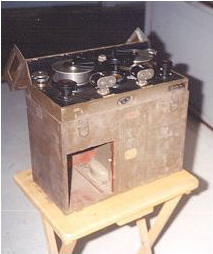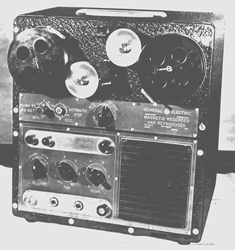Wire recorders continued to be developed and sold in the 1930s and 1940s, but they were produced only in very small quantities. World War II marked a major turning point. While most German companies had already turned to making tape recorders rather than wire recorders, that was not the case elsewhere. The Japanese, for example, were allies of the Germans in World War II, and so probably had some access to German electronics technology, but also had their own set of talented physicists and electrical engineers. They designed an updated version of the Telegraphone and apparently used it for military purposes.

1942 Anritsu wire recorder
In 1939, a student at the Armour Institute of Technology (later renamed Illinois Institute of Technology), Marvin Camras, developed an improved telegraphone that would prove to be very important. While probably he aware of contemporary European wire recorders and the magnetophon tape recorder, Camras developed his own ideas about developing simple, inexpensive, consumer-oriented versions of the machine, in addition to more elaborate models for military, recording studio, or dictation purposes.
In 1940, in part because of his work on wire recorders, he was offered a research position at the Armour Research foundation, an industrial research laboratory operated by the Armour Institute of Technology. Camras and several other researchers improve the designs of his wire recorders and patented many of their key features.
During the war, Armour Research Foundation received a contract from the United States Navy to develop a portable sound recorder. Between 1942 and the end of the war, Armour and a licensed manufacturer, the giant General Electric Company, made as many as a few thousand recorders of two designs. They were joined by a third licensee, Radiotechnic Laboratories, in the mid-1940s. The recorders were used for many purposes throughout the war, most notably as a portable field recorder for journalists.

General Electric’s version of the Armour “military” recorder.
A second inventor, Semi J. Begun, had immigrated to America from Germany in the 1930s, and also began working on magnetic recording. Begun’s experience included participating in the design of a steel tape recorder for the C. Lorenz company in
Germany, which was put into use in radio stations around Europe. After moving to the U.S., he was hired by the Brush Development Company of Cleveland, Ohio, a private firm that would be engaged in, among other things, the development of piezoelectric microphones and phonograph cartridges. At Brush, he designed a series of wire, tape, and magnetic disc recorders for various purposes including sound recording and (analog) data recording.
